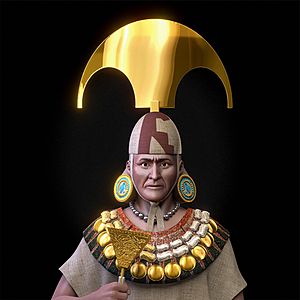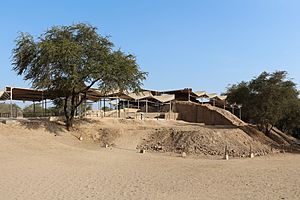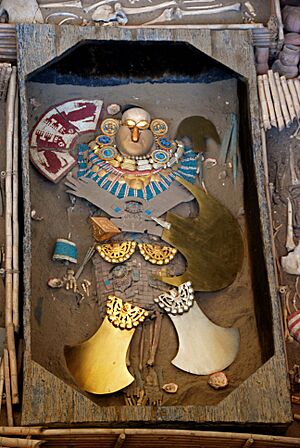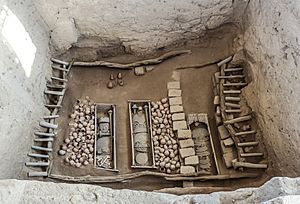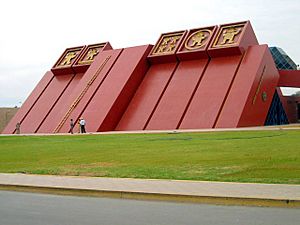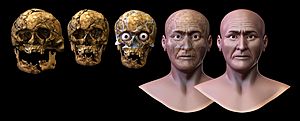Lord of Sipán facts for kids
The Lord of Sipán (El Señor de Sipán) is the name given to an important ancient ruler from the Moche culture in Peru. His tomb was discovered in 1987 at a place called Huaca Rajada, near Sipán, Peru. An archaeologist named Walter Alva led the team that found it.
Many experts believe this discovery was one of the most important archaeological finds in South America in the last 30 years. This is because the main tomb was found completely untouched by looters. By 2007, fourteen tombs had been found at Huaca Rajada.
A special museum, called the Royal Tombs of Sipán Museum, was built nearby in Lambayeque. It opened in 2002 and holds most of the amazing objects found in the tombs. Dr. Alva is the director of this museum.
Contents
Where Was the Lord of Sipán Found?
The Moche tombs at Huaca Rajada are located near the town of Sipán. This area is in the Lambayeque Valley, in the northern part of Peru. It's close to the coast, about 20 miles east of the city of Chiclayo and 30 miles from Lambayeque.
What is Huaca Rajada?
A Huaca is a type of ancient monument built by the Moche and other cultures in South America. The Huaca Rajada site has two small adobe pyramids and a low platform. The Moche people built the platform and one pyramid before 300 AD. Another culture built the second pyramid around 700 AD.
Sadly, many huacas were robbed by the Spanish long ago, and looting continues to be a problem today. In early 1987, looters found some gold objects at Huaca Rajada. A disagreement among them led to the police being called. The police recovered some items and told Dr. Alva about the site, which led to the official archaeological discovery.
Who Was the Lord of Sipán?
Scientists studied the skeleton of the Lord of Sipán. They found he was about 1.63 meters (about 5 feet 4 inches) tall. He was around 35 to 45 years old when he died.
His jewelry and ornaments showed he was a very important leader. These items included fancy headdresses, a face mask, a gold chest plate (called a pectoral) shaped like a man's head and an octopus body, necklaces, nose rings, and earrings. Most of these beautiful objects were made from gold, silver, copper, and colorful stones.
The Lord of Sipán wore two special necklaces with beads shaped like peanuts. These peanuts were made of gold and silver. Peanuts were an important food for the Moche. The necklaces had ten gold peanuts on the right side, representing men and the sun god. On the left side, there were ten silver peanuts, representing women and the moon god. The peanuts symbolized that people came from the earth and return to it after death.
The Lord of Sipán's Burial
When the Lord of Sipán was buried, six other people were placed in his tomb with him. These included three young women (perhaps companions), two men (likely warriors), and a child about nine or ten years old. Another man, possibly a warrior, was found sitting in a small space above the burial chamber. A dog, probably the Lord of Sipán's pet, was also found.
The warriors buried with the Lord of Sipán had their feet removed. This might have been done to prevent them from leaving the tomb in the afterlife. The women were dressed in special ceremonial clothes. Besides the people and the dog, archaeologists found 451 ceremonial items and gifts in the tomb. They also found the remains of two llamas.
Other Tombs at Sipán
In 1988, another tomb was found near the Lord of Sipán's. The objects in this tomb seemed to be connected to religion. They included a cup for ceremonies and a metal crown with an owl. Experts believe the person in this tomb was a Moche priest. Carbon dating showed this priest lived around the same time as the Lord of Sipán.
The third tomb found at Huaca Rajada was a bit older than the first two. However, the items inside showed that this person was also a very high-ranking leader. DNA analysis showed that this person was related to the Lord of Sipán through his mother's side of the family. Because of this, archaeologists named him The Old Lord of Sipán. This third tomb also held the remains of two other people: a young woman, likely buried to accompany the Old Lord, and a man with removed feet, possibly meant to be his guardian.
In total, fourteen tombs have been discovered at Sipán.
What DNA Testing Revealed
Archaeological research and DNA testing helped scientists figure out what the Lord of Sipán looked like. They could learn about his skin color, the shape of his lips, his hair, eyes, and other facial features. This information also helped them accurately guess his age when he died, which allowed researchers to create a very good facial reconstruction.
The Royal Tombs of Sipán Museum
The Royal Tombs of Sipán Museum is located in Lambayeque. It displays most of the important objects found at Huaca Rajada, including the Lord of Sipán and the items from his burial. Dr. Alva helped create and support the building of this museum, which opened in 2002. The museum's design looks like the ancient Moche tombs. Dr. Alva is the director of the museum. In 2009, a smaller museum was also opened right at the Huaca Rajada site.
See also
- In Spanish: Señor de Sipán para niños


